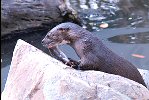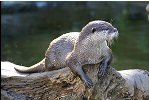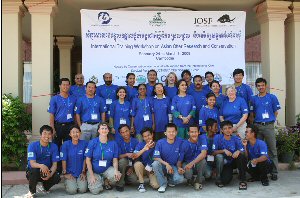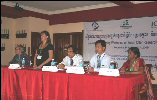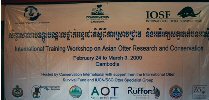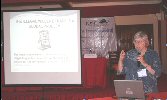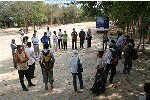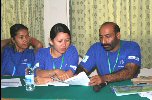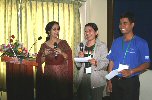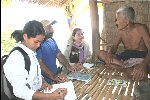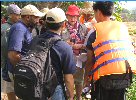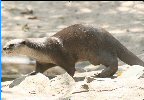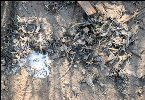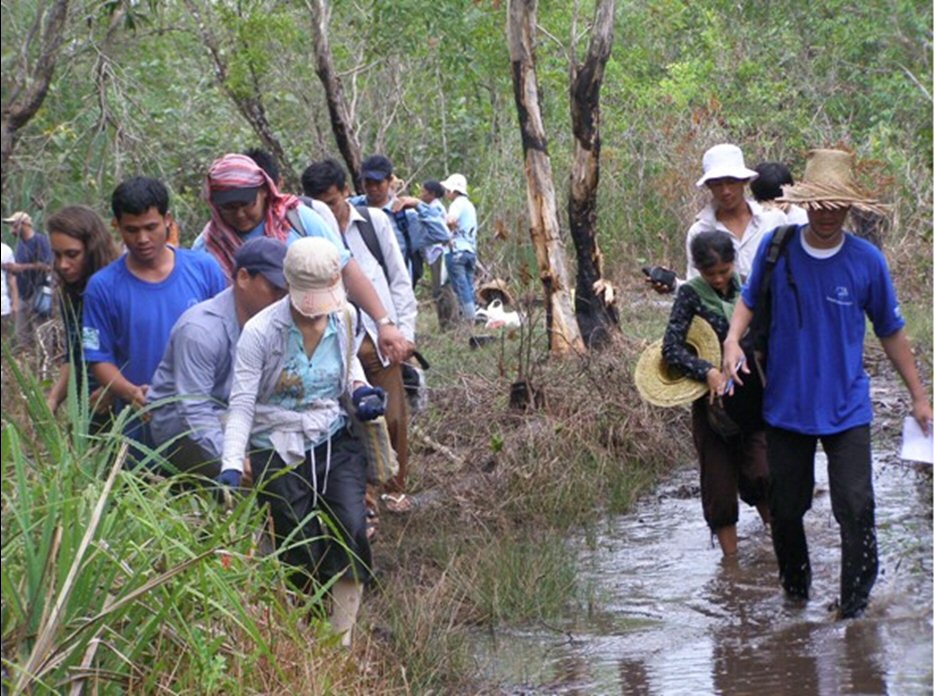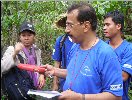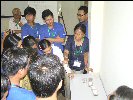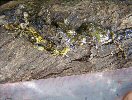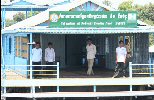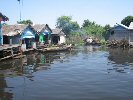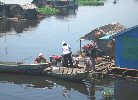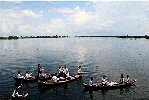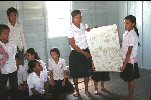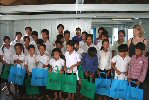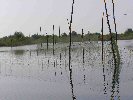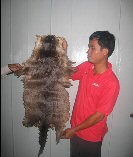 |
Last Update:
Thursday November 22, 2018
|
| [Home] |
|
IUCN/SCC Otter Specialist Group Bulletin Volume 26 Issue 2 Pages 65 - 131 (October 2009) Workshop Report INTERNATIONAL TRAINING WORKSHOP ON ASIAN OTTER RESEARCH AND CONSERVATION February 24th to March 3rd, 2009 Cambodia Carol Bennetto A BIT OF BACKGROUND It happened over a cup of coffee at the Xth International Otter Colloquium in South Korea in 2007. Annette Olsen (Conservation International), Lesley Wright, Grace Yoxon (International Otter Survival Fund), and I commented on the presentations we had heard about the huge decline of otters in Asia and decided that to make the research worthwhile, we would have a go at doing something. So Furget-me-not was born, along with the concept of an otter workshop in Cambodia, if we could get the funding. Furget-me-not is a campaign of the IOSF and during the last year a lot of awareness and fundraising has taken place despite the poor economic climate. In Dec 2007 Dara, the world’s only captive hairy-nosed otter, was rescued from his captors where he would have been doomed for the fur trade. He was sent to Phnom Tamau Wildlife Rescue Centre where a new pen had to be built, and which was paid for by the IOSF through fundraising mainly by Knowsley Safari Park. The Rescue Centre then lost its funding from Wild Aid as they pulled out of Cambodia, so as a result all the otters at the Centre needed feeding: 11 smooth-coated and 1 hairy-nosed otter. Wild Aid has recently returned, but Furget-me-not and IOSF continue to feed and support the otters here. Fundraising included ‘Dara’s day’ at town centres and zoos, jumble sales, street events, and raffles: anywhere where we could raise awareness, and generate funds. THE WORKSHOP HAPPENED The workshop was organised and hosted by Annette Olssen and her colleagues from Conservation International, Cambodia Programme, and also funded by IOSF Furget-me-not, Asian Otter Trust, Rufford Maurice Laing Foundation, and Twycross Zoo UK. Also involved were the Cambodian Forestry Administration, Fisheries Administration, and Ministry of the Environment, who as partners on the ground, have taken a keen interest in otter conservation, and who are working with Conservation International both in-situ and ex-situ to protect otters in Cambodia. The Cambodian Otter Conservation Project was initiated in 2006 as a partnership between Conservation International and the Forestry Administration. The project initially focussed on conducting surveys in Cambodia to learn more about the range and status of otter species. The project found a population of hairy-nosed otters on Tonle Sap Lake, and probably the world’s largest population, so a lot of effort has gone on to protect the species here. Cambodia is a crucially important country for global conservation of otters. Three of Asia’s species live in Cambodia: The Asian small-clawed otter, Aonyx cinerea, the smooth-coated otter, Lutra perspicillata, and the Hairy-nosed otter, Lutra sumatrana. All of these species are threatened throughout Asia by degradation of wetlands, depletion of food sources and hunting for the wildlife trade. Otters are harvested in their thousands throughout the region because their fur gets a high price in the illegal wildlife trade. The smooth-coated otter (Figure 2), is relatively abundant in Cambodia (although very rare worldwide and is classified by the IUCN as vulnerable with an urgent need for conservation action to prevent extinction). The hairy-nosed otter (Figure 1) is probably the world’s rarest otter, and was believed to be extinct until a few isolated and highly threatened populations were recently found. A 2008 assessment of the status of this species has led them being listed as Endangered on the IUCN Red List. This species is still found in Cambodia. The small-clawed otter (Figure 3) has recently been up-listed to vulnerable on the Red List as it has been hunted extensively throughout Asia. This species is still found in Cambodia. The Eurasian otter (Figure 4, listed as lower risk as in Europe and northern Asia the populations are stable) however is under severe threat in the South East Asian part of its range.
The local understanding of the importance of the conservation of otters is very low in Cambodia. Despite the Forestry Administration listing 2 species on the rare list of nationally protected species, many decision makers and Protected Area managers are unaware of the global importance of Cambodia’s otter populations. Compared to other ‘high status’ species, such as tigers and elephants, otters have received little attention. This is mainly due to a lack of funding, research and conservation actions focusing on these species. The workshop was arranged to help improve the interest, awareness and for support for protection of otters in Cambodia, and to build much needed research capacity and knowledge in Cambodian university students and government staff, as well as international researchers (Figure 5).
The Objectives The objectives of the workshop were to:
The Hairy-Nosed Otter In 2008, Wright et al published a paper on the status of the hairy-nosed otter summarizing all that we knew about hairy-nosed otters at the end of 2008. CI is currently developing extensive research and conservation at key sites at Tonle Sap Lake to undertake in-depth studies of the hairy-nosed otters here, and through training, awareness, and community based activities, to improve the conservation of otters and other wildlife. As a result of the workshop Cambodian students are conducting surveys at key sites to identify more sites with hairy-nosed otters. AND NOW THE WORKSHOP The workshop lasted for 8 days and was action-packed. Day 1 The first day focused on the global conservation status of otters, their threats, and specific issues and opportunities for otter conservation in Cambodia. Several key Government representatives were invited to help raise awareness and interest in otter conservation in Cambodia (Figure 6 - 8). Classroom based training of students by Cambodian and international otter experts followed. This was done by PowerPoint presentations, interactive role play - which really helped us to get to know each other - and discussions. There was a pre-course test for the students (and for us all just to check our knowledge!).
Day 2 Early start and off to Phnom Tamau Wildlife Rescue Centre (Figure 9) to meet the Director, Mr Ratanapich, and Nick Marx from Wild Aid, who lives on a shoe string but is a key player at the Centre, and who works tirelessly for the rescue of illegally kept animals. We visit the otter enclosures, and some of the other rare, captive wildlife there, some of which will be released. There is a strong emphasis here on rehabilitation.
From there we travel to Koh Kong town, the biggest part of the road having been only tarmaced last year. Day 3 Classroom based activities today started with ecology and threats to Asian otters, tracks and signs, camera trapping, otter observations, project design and development (research questions, methods, and site selection), spraint analysis, and finishing with the student presentations (Figures 10 and 11). In the evening the students became the tutors, and had much fun as we learnt Cambodian dancing.
Day 4 More class room based activities covering how to do an otter survey, and social surveys with role play practice. We covered how to use GPS, map reading, and field safety. Then after lunch off the field site, to the river Tatai Krom where we went down stream in small boats to interview an indigenous family (Figures 12 and 13) to do initial field observations, and to put into practice what had been learnt in the classroom (Figure 14). We were divided into small groups supervised by a trainer. We all recorded our data, and we presented the results to the group on the last day. We were practicing how to carry out a survey, record, analyze and present data.
Day 5 Back to the field but further downstream to practice camera trapping, tracks and signs practical (smooth-coated otter (Figures 15 - 21) surveying and habitat assessment. A lot of hands-on experience today – well, feet in mud anyway! We were given lunch here, cooked by the local family, and we all ate in their house and dried off after we got totally soaked in the morning (Figure 22). Day 6 Scat analysis practical (Figure 23), student time on project development, and bus back to Phnom Penh
Day 7 Early start to Tonle Sap Lake where 2 hours later we board a boat to one of the communities living on boats in the flooded forest. The area is now protected and managed by CI and the Cambodian Fisheries Administration. It is great otter habitat here, and has small fishing communities living within the area. Annette has been doing a lot of conservation work here with the community, and with which CI has started collaboration for habitat and wildlife protection, including otters. Annette has been doing education work here with the school teacher and with the children in the school. There are 15 children in the school, and in groups of 3 they gave a presentation of the paintings they had drawn, each with a conservation message about their environment and the wildlife. (This is part of a large project CI has started here at this and other villages) It was hard to choose a winner! There were 3 judges, Padma, Hussein, and myself. See Figures 25 – 33. After lunch prepared by the community, we set off in small boats and at one site we found scats of hairy-nosed otters on a low branch of a tree, in the flooded forest habitat (Figure 24). Day 8 Student presentations and projects, student tests, and otter Olympics. Presentation of certificates, and dinner in the evening with sad goodbyes.
During the workshop the Cambodian students were given time to develop proposals for future studies in otter research and conservation. Of the final 6 proposals, 2 were selected. The 2 chosen were partly selected because the results will greatly contribute to the knowledge of otters in Cambodia which will be very useful for future planning of conservation efforts, and partly because these students showed great motivation and interest to work with otter research. One group of students will carry out a project with the title ‘Food and habitats of smooth-coated and small-clawed otters at Kashep Stream, Veun Sia district, Ratanakiri province’. The other team will carry out a project titled ‘Exploration of species and distribution of otters at Tropeang Rong Koh Kong Province’. These projects have now started, thanks to the support of CI, Furget-me-not and IOSF. AND A FINAL NOTE The workshop was a success in many ways. A large number of Cambodian University students were trained in otter research, were keen to learn and showed a lot of interest and gained a great experience. Annette believes we managed to create a group of future otter (and other wildlife) researchers in the academic world in Cambodia. By supporting these students in future otter focused work we will keep their interest and motivation. During the first half day, where government representatives were invited, we seem to have created better awareness of otter conservation and interest in the government, which is so important for the future otter-focused work in Cambodia. The government-run Phnom Tamao Wildlife and Rescue Centre holds the only hairy-nosed Otter in captivity in the world and is therefore crucially important for this species. Nicole Duplaix, Annette, and I, met with the director of the centre and discussed opportunities for ex-situ conservation work for otters. This meeting was very positive and had great outcomes based on collaboration and knowledge sharing for keeping and breeding hairy nosed otters. After a request from government staff, the deputy chair of the IUCN Otter Specialist group, Nicole Duplaix, and Annette, met the Director of the Cambodian Forestry Administration, who is directly responsible for conservation of otters in Cambodia. The meeting went well and the director of the FA showed great support for otter conservation. One Cambodian language newspaper and one English newspaper covered the first morning of the workshop, with following articles in the newspapers and mention on national radio, which greatly helped to spread awareness about otters and their conservation importance to Cambodia. Trainees from Indonesia, Vietnam, Malaysia, Thailand and Pakistan also joined the workshop. They were either students or researchers, with a special interest in otters. They all thought the course improved their skills enormously and were eager to return home to apply their knowledge to their own work. Having people in the workshop from so many countries all interested in and learning about otters was such a great way of creating a strong network with collaboration across the whole region. This will greatly improve communication and collaboration and sharing of knowledge in the future. Several of the trainers at the workshop, who are also members of the IUCN Otter Specialist Group, got the chance to meet, to catch up and discuss thoughts and ideas for conservation activities in the future. It was agreed that this kind of training was very useful and should be repeated in other Asian countries, when possible. It is a great way to get young people trained and motivated to carry out other otter related work and to enforce the networks and to share the experiences. REFERENCES Wright, LC, Olsson, A and Kanchanasaka, B (2008). A Working Review of the Hairy-Nosed Otter (Lutra sumatrana). IUCN Otter Spec. Group Bull. 25 (1): 38 - 59 GLOSSARY
|
||||||||||||||||||||||||||||||||||||||||||||||||||||||||||||||||
| [Copyright © 2006 - 2050 IUCN/SSC OSG] | [Home] | [Contact Us] |
